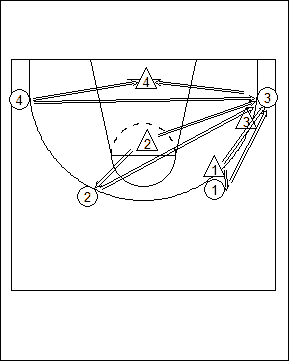Vision in the Flat Triangle
The heart and soul of a good defensive unit is not that each individual is a fantastic defensive player, but that the Help Defence is ready, willing and able to make the right read. For a truly great defensive unit to be created it requires a shift in mindset by players from guarding the ball one on one, to all five defensive players working to guard the ball.
Help Defence refers to all players not guarding the player with the ball directly. Players are usually referred to as either one, two or three passes away from the ball (Refer to the diagram below). As a general indication about positioning, if playing a half court man to man defensive system the help defender one pass away should be ball side of their offensive player (One) just below the passing lane. The Player two passes away should be in the keyway (Two). A player two passes away should have as a minimum have one foot in and one foot outside the keyway. The help defender three passes away should be on the split line at the basket (Four).
No matter the position of the help defender they should be focused on creating what is call a Flat Triangle between themselves, their defensive assignment and the offensive player with the ball.

The diagram above illustrates the flat triangle needing to be created by the help defenders in various positions on the floor. The most important aspects of a help defenders technique is maintaining vision. Without vision of the ball the help defender will be slow to react and not make the correct read in the time required to be most effective.
There are two techniques utilised for maintaining vision of the ball. The first is to ask your players to assume a low and wide defensive stance and move below the direct line passing line between the offensive player with the ball, and their defensive assignment. As they move their peripheral vision will widen and eventually they will be able to see both defenders without turning their head. In the diagram above if Four (4) looks directly towards Two the player should be able to see both offensive players Three and Four in their peripheral vision.
The second technique is for the defensive player to constantly turn their head to see both the ball and their defensive assignment. This technique requires the defensive player to be very active in constantly assessing the state of play and being aware of players they are not necessarily looking at.
So which technique is best?
There are a number of factors to consider. The first is using the peripheral technique has a clear advantage in being able to maintain constant vision of the ball with in a flat triangle position. It allows the defensive player to see the whole court more effectively and efficiently. The issue with this technique is that using your peripheral vision is a skill in itself. Each person will have developed this sense differently and so some individuals will forever struggle to make this a part of the defensive skill set. For adolescent athletes and senior athletes this will be the technique of choice when coupled with the flat triangle positioning. This is the obvious inner for elite players as well as losing vision of your player could mean the difference between stopping an aggressive cut and finding yourself being posted up under the basket.
Turning your head limits vision and at the end of the day, this is the information onto which players will base their read and act upon. Turning the head is a more appropriate technique for younger players as they can struggle with the use and development of their peripheral vision.
One benefit which is worth mentioning about the technique of turning the head is it allows excellent vision and therefore faster reaction by the help defender to the ball handler and ball movement. Too much movement in a player’s peripheral vision can become confusing and they will have to break this technique to look directly at the play.
The choice between the two options is really left to the coach and the types of success they will have with each technique while focusing on the flat triangle position. For some teams one technique will be a clearly better executed option for that playing group. For others you are able to use both techniques with good success rates. Try both techniques and see which one produces the best results for your team.







Leave a Reply